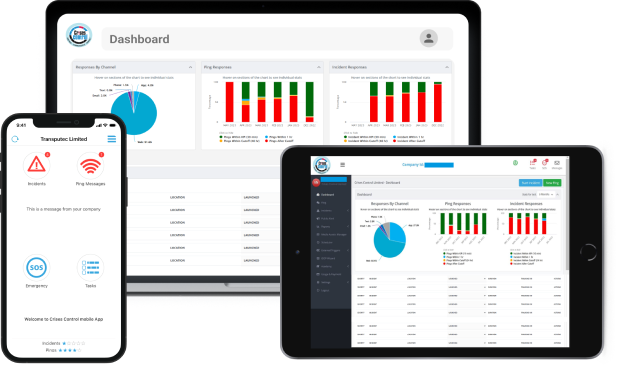Written by Anneri Fourie | Marketing Executive
Effective incident response planning is crucial for any organisation to navigate through crises smoothly. One of the most impactful methods to prepare your team for potential disasters is through Tabletop Exercises.
In this detailed guide, we will explore how to conduct incident response tabletop exercises, and how Crises Control can support your organisation in enhancing its disaster preparedness strategy.
What are Incident Response Tabletop Exercises?
Think of an incident response (IR) tabletop exercise as a war room for a simulated security incident. Unlike full-scale exercises that involve deploying resources and equipment, tabletop exercises are discussion-based activities conducted in a low-cost, low-disruption environment.
Here’s how they work: a facilitator guides participants through a pre-defined scenario, injecting details and challenges as the exercise progresses. The team discusses how they would respond, identifies roles and responsibilities, and considers potential roadblocks. The facilitator encourages open communication, allowing participants to ask questions, raise concerns, and explore different response strategies.
Why Conduct Incident Response Tabletop Exercises?
These exercises are more than just a box to check on your cybersecurity preparedness list. Here’s how incorporating tabletop exercises into your strategy benefits your organisation:
- Sharpened Team Coordination: Silos crumble during tabletop exercises. By working through a simulated incident together, team members from IT security, legal, communications, and other departments become familiar with each other’s roles and communication styles. This fosters a cohesive response approach when a real incident strikes.
- Enhanced Communication Flow: Effective communication is the lifeblood of successful IR. Tabletop exercises provide a safe space to practise communication protocols, identify potential gaps, and ensure clear and concise information flows throughout the team and organisation.
- Plan Validation and Improvement: Think of these exercises as a stress test for your existing IR plan. By working through a scenario, you can uncover weaknesses in your plan, identify areas for improvement, and ensure your response aligns with best practices.
- Confidence Boost for Your Team: Tabletop exercises provide valuable training in a low-pressure environment. This allows team members to practise their decision-making skills and builds confidence in their ability to handle the stress and uncertainty of a real-world incident.
- Proactive Threat Identification: By simulating different incident scenarios, you can proactively identify potential threats and vulnerabilities within your organisation. This allows you to take preventative measures and mitigate risks before they escalate into major incidents.
Building a Successful Tabletop Exercise: A Step-by-Step Guide

Now that you understand the value proposition, let’s delve into how to conduct effective tabletop exercises:
1. Define Your Objectives and Scope
Start with a clear roadmap. Define the objectives you want to achieve with the exercise. Are you focusing on testing a specific aspect of your IR plan, such as containment and eradication procedures? Or do you aim to assess team communication during a major incident?
Once you’ve established your objectives, determine the scope of the exercise. Will it focus on a specific type of incident, such as a ransomware attack or a data breach? Consider the most prevalent threats your organisation faces and prioritise scenarios that pose the greatest risk.
2. Assemble Your Response Team
The right people are key to a successful exercise. Assemble a team that reflects the composition of your actual IR team. This includes representatives from IT security, legal, communications, human resources, and any other departments that would play a role in a real-world incident.
3. Craft a Realistic Scenario
A realistic and engaging scenario is crucial. Base your scenario on real-world threats and incidents relevant to your industry. Inject technical details and unexpected twists and turns to keep the team engaged and challenge their decision-making skills.
4. Designate a Skilled Facilitator
Select a facilitator who is knowledgeable about IR best practices and comfortable managing group discussions. The facilitator will guide the team through the scenario, pose questions, and ensure the exercise remains focused on your pre-defined objectives.
5. Conduct the Exercise and Foster Discussion
Set the stage for a productive exercise by creating a comfortable and collaborative environment. Begin by outlining the scenario, providing key details about the incident, and establishing the initial timeline.
As the facilitator, guide the team through the decision-making process, encouraging open communication and discussion. Present challenges and roadblocks to test their critical thinking and problem-solving skills. Allow ample time for participants to ask questions and explore different response strategies.
6. Debrief and Document for Improvement
Following the exercise, hold a debriefing session to discuss key takeaways, lessons learned, and areas for improvement. Capture key observations and recommendations in a detailed after-action report. This report will serve as a valuable reference point for future tabletop exercises and plan updates.
Here are some additional tips to ensure a successful debriefing session:
- Focus on solutions, not blame: The goal is to identify areas for improvement, not assign blame. Encourage open and honest discussion about what worked well and what could be improved.
- Gather feedback from participants: Solicit feedback from all participants regarding the scenario, facilitation, and overall value of the exercise. This feedback will help you refine future exercises and ensure they continue to meet your team’s needs.
- Assign action items: Based on the debriefing discussion, identify specific action items to address any weaknesses or gaps identified in the exercise. Assign ownership and deadlines for these action items to ensure they are addressed promptly.
Beyond the Tabletop: Considerations for a Comprehensive Incident Response Program
While tabletop exercises are a powerful tool, they are just one piece of the puzzle. To build a truly robust IR program, consider these additional elements:
- Regular Training: Supplement tabletop exercises with ongoing training programs to ensure your team stays up-to-date on the latest threats, attack vectors, and best practices.
- Investment in Technology: Invest in security tools and technologies, like Crises Control, that can aid in incident detection, containment, eradication, and recovery efforts.
- Incident Response Plan Updates: Regularly review and update your plan based on lessons learned from tabletop exercises, real-world incidents, and evolving threats.
Don’t Wait for a Real Incident to Test Your Response
By incorporating tabletop exercises into your preparedness strategy, you can significantly enhance your organisation’s ability to respond effectively to security incidents. These exercises provide a safe and controlled environment to test your plan, identify vulnerabilities, and build a more cohesive and confident team.
Ready to Sharpen Your Response and Be Incident Ready?
Contact Crises Control today to discuss how we can help you develop and implement a comprehensive IR program, including facilitating tabletop exercises and creating a culture of cybersecurity awareness within your organisation.
Request a FREE Demo









